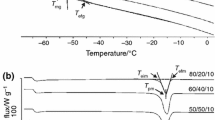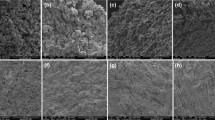Abstract
To provide guidance for the practical thermal processing and applications of poly(propylene carbonate)/poly(vinyl alcohol) (PPC/PVA) blend, an environmentally friendly material with wide potential applications, thermogravimetric analysis (TG) and thermogravimetric-Fourier transform infrared spectroscopy (TG-FTIR) were adopted to investigate the thermal decomposition behavior of PPC in PPC/PVA blend for its worse high-temperature thermal stability, and the decomposition processes were analyzed by Chang’s method. Accordingly, the precise kinetic parameters of each thermal decomposition process were calculated by Flynn–Wall–Ozawa method. The results showed that neat PPC underwent three pyrolysis stages: unzipping, unzipping and chain random scission and unzipping. For PPC/PVA blend, the elimination reaction of the side-hydroxyl groups of PVA promoted the chain random scission of PPC, thus playing the dominant role in the thermal decomposition of PPC. The more the hydroxyl groups in PVA were, the lower the thermal stability of the blends would be. On the basis of above, a rational decomposition mechanism of PPC accelerated by PVA was proposed: With the increase in temperature, the elimination reaction of the hydroxyl groups of PVA occurred to release H+ protons; then, the H+ protons attacked the PPC backbone to release CO2 by chain random scission, leading to a rapid mass loss of PPC in PPC/PVA blend during 200–250 °C.









Similar content being viewed by others
References
Xing P, Ai X, Dong L, Feng Z. Miscibility and crystallization of poly(β-hydroxybutyrate)/poly(vinyl acetate-co-vinyl alcohol) blends. Macromolecules. 1998;31(20):6898–907.
Mohanty A, Misra M, Hinrichsen G. Biofibers, biodegradable polymers and biocomposites: an overview. Macromol Mater Eng. 2000;276(1):1–24.
Martin O, Averous L. Poly(lactic acid): plasticization and properties of biodegradable multiphase systems. Polymer. 2001;42(14):6209–19.
Vilaseca F, Mendez J, Pelach A, Llop M, Canigueral N, Girones J, et al. Composite materials derived from biodegradable starch polymer and jute strands. Process Biochem. 2007;42(3):329–34.
Lim L-T, Auras R, Rubino M. Processing technologies for poly(lactic acid). Prog Polym Sci. 2008;33(8):820–52.
Siró I, Plackett D. Microfibrillated cellulose and new nanocomposite materials: a review. Cellulose. 2010;17(3):459–94.
Woodruff MA, Hutmacher DW. The return of a forgotten polymer—polycaprolactone in the twenty-first century. Prog Polym Sci. 2010;35(10):1217–56.
Xu J, Guo BH. Poly(butylene succinate) and its copolymers: research, development and industrialization. Biotechnol J. 2010;5(11):1149–63.
Luinstra GA. Poly(propylene carbonate), old copolymers of propylene oxide and carbon dioxide with new interests: catalysis and material properties. Polym Rev. 2008;48(1):192–219.
Cui S, Li L, Wang Q. Enhancing glass transition temperature and mechanical properties of poly(propylene carbonate) by intermacromolecular complexation with poly(vinyl alcohol). Compos Sci Technol. 2016;127:177–84.
Ma X, Yu J, Wang N. Compatibility characterization of poly(lactic acid)/poly(propylene carbonate) blends. J Polym Sci Part B Polym Phys. 2006;44(1):94–101.
Ma X, Chang PR, Yu J, Wang N. Preparation and properties of biodegradable poly(propylene carbonate)/thermoplastic dried starch composites. Carbohydr Polym. 2008;71(2):229–34.
Pang M, Qiao J, Jiao J, Wang S, Xiao M, Meng Y. Miscibility and properties of completely biodegradable blends of poly(propylene carbonate) and poly(butylene succinate). J Appl Polym Sci. 2008;107(5):2854–60.
Tao J, Song C, Cao M, Hu D, Liu L, Liu N, et al. Thermal properties and degradability of poly(propylene carbonate)/poly(β-hydroxybutyrate-co-β-hydroxyvalerate)(PPC/PHBV) blends. Polym Degrad Stab. 2009;94(4):575–83.
Xing C, Wang H, Hu Q, Xu F, Cao X, You J, et al. Mechanical and thermal properties of eco-friendly poly(propylene carbonate)/cellulose acetate butyrate blends. Carbohydr Polym. 2013;92(2):1921–7.
Thomas P, Guerbois J-P, Russell G, Briscoe B. FTIR study of the thermal degradation of poly(vinyl alcohol). J Therm Anal Calorim. 2001;64(2):501–8.
Dong W, Wang Y, Huang C, Xiang S, Ma P, Ni Z, et al. Enhanced thermal stability of poly(vinyl alcohol) in presence of melanin. J Therm Anal Calorim. 2014;115(2):1661–8.
Taghizadeh MT, Yeganeh N, Rezaei M. The investigation of thermal decomposition pathway and products of poly(vinyl alcohol) by TG-FTIR. J Appl Polym Sci. 2015;132(25):42117–29.
Wang Y, Xiang C, Li T, Ma P, Bai H, Xie Y, et al. Enhanced thermal stability and UV-shielding properties of poly(vinyl alcohol) based on Esculetin. J Phys Chem B. 2017;121(5):1148–57.
Liu B, Chen L, Zhang M, Yu A. Degradation and stabilization of poly(propylene carbonate). Macromol Rapid Commun. 2002;23(15):881–4.
Li XH, Meng YZ, Zhu Q, Tjong SC. Thermal decomposition characteristics of poly(propylene carbonate) using TG/IR and Py-GC/MS techniques. Polym Degrad Stab. 2003;81(1):157–65.
Liu B, Zhao X, Wang X, Wang F. Thermal degradation kinetics of poly(propylene carbonate) obtained from the copolymerization of carbon dioxide and propylene oxide. J Appl Polym Sci. 2003;90(4):947–53.
Peng S, An Y, Chen C, Fei B, Zhuang Y, Dong L. Thermal degradation kinetics of uncapped and end-capped poly(propylene carbonate). Polym Degrad Stab. 2003;80(1):141–7.
Varghese JK, Na SJ, Park JH, Woo D, Yang I, Lee BY. Thermal and weathering degradation of poly(propylene carbonate). Polym Degrad Stab. 2010;95(6):1039–44.
Chang WL. Decomposition behavior of polyurethanes via mathematical simulation. J Appl Polym Sci. 1994;53(13):1759–69.
Thanki JD, Parsania PH. Dynamic DSC curing kinetics and thermogravimetric study of epoxy resin of 9,9′-bis (4-hydroxyphenyl) anthrone-10. J Therm Anal Calorim. 2017;130(3):2145–56.
Ozawa T. A new method of analyzing thermogravimetric data. Bull Chem Soc Jpn. 1965;38(11):1881–6.
Flynn JH, Wall LA. General treatment of the thermogravimetry of polymers. J Res Natl Bur Stand. 1966;70(6):487–523.
Ozawa T. Thermal analysis—review and prospect. Thermochim Acta. 2000;355(1–2):35–42.
Zanatta ER, Reinehr TO, Awadallak JA, Kleinübing SJ, dos Santos JBO, Bariccatti RA, et al. Kinetic studies of thermal decomposition of sugarcane bagasse and cassava bagasse. J Therm Anal Calorim. 2016;125(1):437–45.
Doyle C. Estimating isothermal life from thermogravimetric data. J Appl Polym Sci. 1962;6(24):639–42.
Ramesan MT, George A, Jayakrishnan P, Kalaprasad G. Role of pumice particles in the thermal, electrical and mechanical properties of poly(vinyl alcohol)/poly(vinyl pyrrolidone) composites. J Therm Anal Calorim. 2016;126(2):511–9.
Taghizadeh MT, Yeganeh N, Rezaei M. Kinetic analysis of the complex process of poly(vinyl alcohol) pyrolysis using a new coupled peak deconvolution method. J Therm Anal Calorim. 2014;118(3):1733–46.
Acknowledgements
This work was financially supported by the National Natural Science Foundation of China (51433006), Program of Innovative Research Team for Young Scientists of Sichuan Province (2016TD0010), Program of Introducing Talents of Discipline to Universities and State Key Laboratory of Polymer Materials Engineering (Grant No. sklpme2014-1-04).
Author information
Authors and Affiliations
Corresponding author
Rights and permissions
About this article
Cite this article
Cui, S., Wei, P. & Li, L. Thermal decomposition behavior of poly(propylene carbonate) in poly(propylene carbonate)/poly(vinyl alcohol) blend. J Therm Anal Calorim 135, 2437–2446 (2019). https://doi.org/10.1007/s10973-018-7297-5
Received:
Accepted:
Published:
Issue Date:
DOI: https://doi.org/10.1007/s10973-018-7297-5




